The AMD Radeon R9 290X Review
by Ryan Smith on October 24, 2013 12:01 AM EST- Posted in
- GPUs
- AMD
- Radeon
- Hawaii
- Radeon 200
GRID 2
The final game in our benchmark suite is also our racing entry, Codemasters’ GRID 2. Codemasters continues to set the bar for graphical fidelity in racing games, and with GRID 2 they’ve gone back to racing on the pavement, bringing to life cities and highways alike. Based on their in-house EGO engine, GRID 2 includes a DirectCompute based advanced lighting system in its highest quality settings, which incurs a significant performance penalty but does a good job of emulating more realistic lighting within the game world.
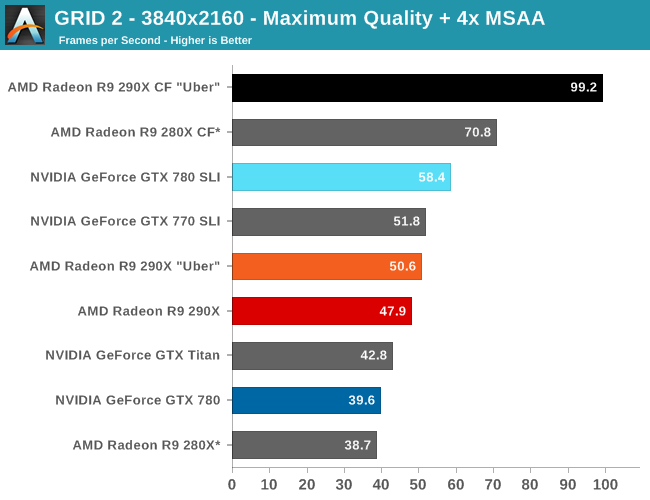
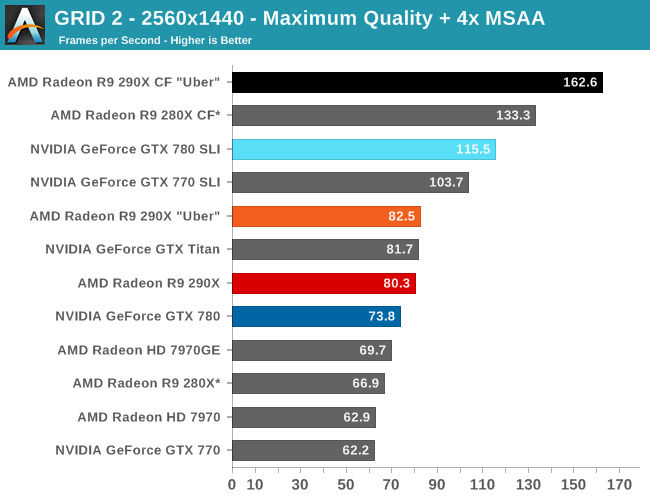
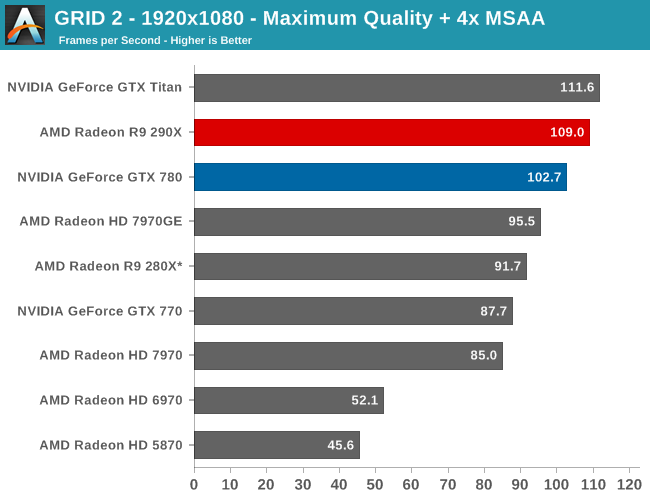
For as good looking as GRID 2 is, it continues to surprise us just how easy it is to run with everything cranked up, even the DirectCompute lighting system and MSAA (Forward Rendering for the win!). At 2560 the 290X has the performance advantage by 9%, but we are getting somewhat academic since it’s 80fps versus 74fps, placing both well above 60fps. Though 120Hz gamers may still find the gap of interest.
Moving up to 4K, we can still keep everything turned up including the MSAA, while pulling off respectable single-GPU framerates and great multi-GPU framerates. To no surprise at this point, the 290X further extends its lead at 4K to 21%, but as usually is the case you really want two GPUs here to get the best framerates. In which case the 290X CF is the runaway winner, achieving a scaling factor of 96% at 4K versus NVIDIA’s 47%, and 97% versus 57% at 2560. This means the GTX 780 SLI is going to fall just short of 60fps once more at 4K, leaving the 290X CF alone at 99fps.
Unfortunately for AMD their drivers coupled with GRID 2 currently blows a gasket when trying to use 4K @ 60Hz, as GRID 2 immediately crashes when trying to load with 4K/Eyefinity enabled. We can still test at 30Hz, but those stellar 4K framerates aren’t going to be usable for gaming until AMD and Codemasters get that bug sorted out.
Finally, it’s interesting to note that for the 290X this is the game where it gains the least on the 280X. The 290X performance advantage here is just 20%, 5% lower than any other game and 10% lower than the average. The framerates at 2560 are high enough that this isn’t quite as important as in other games, but it does show that the 290X isn’t always going to maintain that 30% lead over its predecessor.
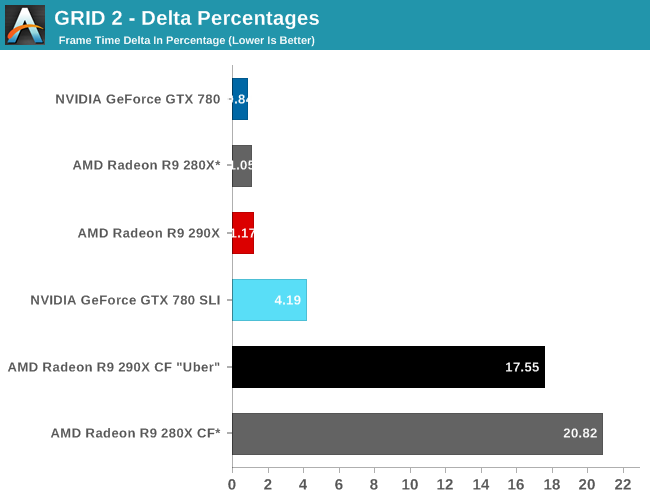
Without any capturable 4K FCAT frametimes, we’re left with the delta percentages at 2560, which more so than any other game are simply not in AMD’s favor. The GTX 780 SLI is extremely consistent here, to the point of being almost absurdly so for a multi-GPU setup. 4% is the kind of variance we expect to find with a single-GPU setup, not something incorporating multiple GPUs. AMD on the other hand, though improving over the 280X by a few percent, is merely adequate at 17%. The low frame times will further reduce the real world impact of the difference between the GTX 780 SLI and 290X CF here, but this is another game AMD could stand some improvements, even if it costs AMD some of the 290X’s very strong CF scaling factor.


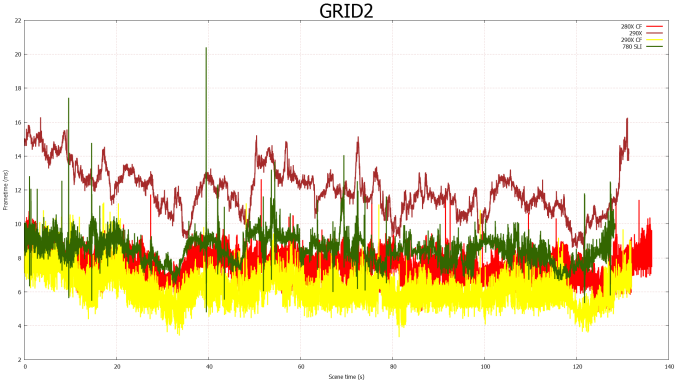








396 Comments
View All Comments
xres625e - Thursday, October 24, 2013 - link
sterven..eddieveenstra - Sunday, October 27, 2013 - link
stoere jongen ben je.... bah.TrantaLocked - Sunday, October 27, 2013 - link
Hm I wonder why I can find the 290X for $550 on newegg?Dal Makhani - Thursday, October 24, 2013 - link
lol AMD fanboy. This card is alright, nothing "uber". It brings some proper pricing sense back into the green team's head which is needed, the gtx 780 will be dropped to R9 290X pricing, and the 780 Ti will be Nvidia's new 650 dollar card. But to justify 100 dollar price difference, i dont know if 780 Ti can show big enough gains. That will be interesting to see next month.tuklap - Thursday, October 24, 2013 - link
I doubt that nvidia gtx 780 will drop price on par with r9 290x..just4U - Thursday, October 24, 2013 - link
I doubt it as well.. They didn't ever really drop prices on the 560Ti until it EOL..mfergus - Thursday, October 24, 2013 - link
Well it's uber in the sense that it brings much needed competition to Nvidia's very high priced high end cards. Nobody should of thought this card was going to be revolutionary though, it's on the same 28nm as all the other cards and it has the same architecture as the 7790 which had very minor compute changes compared to GCN 1.0dragonsqrrl - Thursday, October 24, 2013 - link
Dropping the 780 by $100 is the very least Nvidia would have to do to remain competitive, and personally I don't think that would be nearly enough. The 290X is performance competitive with Titan, and despite the fact that Titan is cooler, quieter, consumes less power, has a much better shroud, and superior DP performance, it should come down to the same price as the 290X to remain competitive due to the slightly higher performance of the 290X. A ~$550 Titan or ~$400 780 would be amazing.mfergus - Thursday, October 24, 2013 - link
I don't expect Titan's price to change much but I could be wrong. I never really thought of it as a standard gaming card, it's a total halo product with lots of memory and the only non Quadro/Tesla with full DP performance. The 780ti will be cheaper than Titan though and faster in gaming performance.Bloodcalibur - Thursday, October 24, 2013 - link
You truly are an idiot if you think that the Titan should be compared to a 290X and that the sentence ends there. The Titan itself only performs a small bit above nvidia's own 780, but the $350 price difference is there for it's compute performance. It's basically a budget workstation card with higher than 780 gaming abilities for those who game AND do a little bit of 3D computing. Derp.This retard actually suggested a gaming/workstation hybrid pried at $1000 should compete downwards with a $550 gaming card.